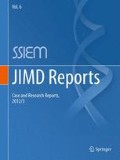Abstract
Deficiency of ornithine-δ-aminotransferase (OAT) in humans results in gyrate atrophy. Early diagnosis may allow initiation of treatment before irreversible damage has occurred. However, diagnosis is commonly delayed well into adulthood because of the nonspecific character of initial symptoms. Here, we report findings in a neonate who was evaluated because of a positive family history of OAT deficiency. The reversed enzymatic flux in early infancy resulted in borderline low ornithine concentration – evoking urea cycle disturbances – and increased proline. In addition, plasma citrulline was low. Consequently, the proline/citrulline ratio in plasma was increased compared to controls. To find out whether amino acid profiling in neonatal dried blood spots is suitable to detect OAT deficiency, we evaluated the original newborn dried blood spots of two affected patients and compared it with a database of >450,000 newborns tested in Minnesota since 2004. Proline concentrations (777 and 1,381 μmol/L) were above the 99 percentile (776 μmol/L) of the general population, and citrulline concentrations (4.5 and 4.9 μmol/L) only just above the 1 percentile (4.37 μmol/L). The proline/citrulline ratio was 172.9 and 281.8, respectively. This ratio was calculated retrospectively in the normal population, and the 99 percentile was 97.6. Applying this ratio for NBS could lead to early and specific detection of neonatal OAT deficiency, with no additional expense to newborn screening laboratories quantifying amino acids. Given that early diagnosis of OAT disease can lead to earlier treatment and prevent visual impairment, further studies are indicated to evaluate whether newborn screening for OAT deficiency is warranted.
Competing interests: None declared
Access this chapter
Tax calculation will be finalised at checkout
Purchases are for personal use only
References
Brody LC, Mitchell GA, Obie C et al (1992) Ornithine delta-aminotransferase mutations in gyrate atrophy. Allelic heterogeneity and functional consequences. J Biol Chem 267:3302–3307
Champion MP, Bird S, Fensom T, Dalton RN (2002) Ornithine aminotransferase deficiency (gyrate atrophy) persenting with hyperammonaemic encephalopathy. J Inherit Metab Dis 25(supplement 1):29
Cleary MA, Dorland L, de Koning TJ et al (2005) Ornithine aminotransferase deficiency: diagnostic difficulties in neonatal presentation. J Inherit Metab Dis 28:673–679
Hayasaka S, Saito T, Nakajima H, Takahashi O, Mizuno K, Tada K (1985) Clinical trials of vitamin B6 and proline supplementation for gyrate atrophy of the choroid and retina. Br J Ophthalmol 69:283–290
Heinanen K, Nanto-Salonen K, Leino L et al (1998) Gyrate atrophy of the choroid and retina: lymphocyte ornithine-delta-aminotransferase activity in different mutations and carriers. Pediatr Res 44:381–385
Kaiser-Kupfer MI, Ludwig IH, de Monasterio FM, Valle D, Krieger I (1985) Gyrate atrophy of the choroid and retina. Early findings. Ophthalmology 92:394–401
Kaiser-Kupfer MI, Caruso RC, Valle D, Reed GF (2004) Use of an arginine restricted diet to slow progression of visual loss in patients with gyrate atrophy. Arch Ophthalmol 122:982–984
Kaneko S, Ando A, Okuda-Ashitaka E et al (2007) Ornithine transport via cationic amino acid transporter-1 is involved in ornithine cytotoxicity in retinal pigment epithelial cells. Invest Ophthalmol Vis Sci 48:464–471
Ohkubo Y, Ueta A, Ito T et al (2005) Vitamin B6-responsive ornithine aminotransferase deficiency with a novel mutation G237D. Tohoku J Exp Med 205:335–342
Santos L, Fiona WJ, Walter JH (2006) Dietary compliance in ornithine aminotransferase deficiency. J Inherit Metab Dis 29:240
Simell O, Takki K (1973) Raised plasma-ornithine and gyrate atrophy of the choroid and retina. Lancet 1:1031–1033
Sulochana KN, Ramakrishnan S, Mahesh L, Punitham R (2000) Possible role of polyamines in gyrate atrophy. Indian J Ophthalmol 48:37–43
Takki K (1974) Gyrate atrophy of the choroid and retina associated with hyperornithinaemia. Br J Ophthalmol 58:3–23
Takki KK, Milton RC (1981) The natural history of gyrate atrophy of the choroid and retina. Ophthalmology 88:292–301
Turgeon C, Magera MJ, Allard P et al (2008) Combined newborn screening for succinylacetone, amino acids, and acylcarnitines in dried blood spots. Clin Chem 54:657–664
Valayannopoulos V, Boddaert N, Mention K et al (2009) Secondary creatine deficiency in ornithine delta-aminotransferase deficiency. Mol Genet Metab 97:109–113
Wang T, Milam AH, Steel G, Valle D (1996) A mouse model of gyrate atrophy of the choroid and retina. Early retinal pigment epithelium damage and progressive retinal degeneration. J Clin Invest 97:2753–2762
Watson MS, Mann MY, Lloyd-Puryear MA, Rinaldo P, Howell RR (2006) Newborn screening:toward a uniform screening panel and systeom executive summary. Genet Med 8:1S–11S
Webster M, Allen J, Rawlinson D, Brown A, Olpin S, Leonard JV (1999) Ornithine aminotransferase deficiency presenting with hyperammonaemia in a premature newborn. J Inherit Metab Dis 22(supplement 1):80
Weleber RG, Kennaway NG (1981) Clinical trial of vitamin B6 for gyrate atrophy of the choroid and retina. Ophthalmology 88:316–324
Acknowledgments
We like to thank David McHugh for technical support on the MN database and Dr. Gepke Visser for support on the DDRMD (Dutch Diagnosis Registration Metabolic Diseases).
Author information
Authors and Affiliations
Corresponding author
Editor information
Editors and Affiliations
Additional information
Communicated by: Rodney Pollitt
Take Home Message
Determining the proline/citrulline ratio in plasma as well as in dried blood spots routinely collected for newborn screening is a tool for neonatal diagnosis of OAT deficiency.
Rights and permissions
Copyright information
© 2012 SSIEM and Springer-Verlag Berlin Heidelberg
About this chapter
Cite this chapter
de Sain-van der Velden, M.G.M. et al. (2012). The Proline/Citrulline Ratio as a Biomarker for OAT Deficiency in Early Infancy. In: JIMD Reports - Case and Research Reports, 2012/3. JIMD Reports, vol 6. Springer, Berlin, Heidelberg. https://doi.org/10.1007/8904_2011_122
Download citation
DOI: https://doi.org/10.1007/8904_2011_122
Received:
Revised:
Accepted:
Published:
Publisher Name: Springer, Berlin, Heidelberg
Print ISBN: 978-3-642-28128-0
Online ISBN: 978-3-642-28129-7
eBook Packages: MedicineMedicine (R0)

